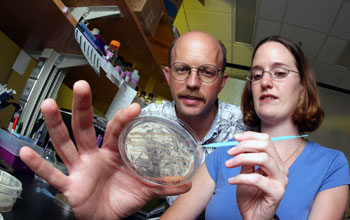Multimedia Gallery
Lowering Salt Content in DNA Solutions
Georgia Institute of Technology Associate Professor Nicholas Hud (left) and Ph.D. student Christine Conwell--along with Ph.D. student Igor Vilfan (not shown)--have made a significant advance in controlling the size of DNA toroids. The finding could improve the efficiency of gene delivery for medical treatment and disease prevention.
Scientists are seeking to understand the natural mechanism of DNA condensation into nanostructures--in particular, toroids, which look like tightly wound garden hoses. Densely packed DNA is nature's efficient way of transporting genetic information, done particularly well by sperm cells and viruses. For more information on this research, see the July 28, 2003, Georgia Tech Research News story, "Hold the Salt, Please: Lowering Salt Content in DNA Solutions May Help Improve Gene Therapy Success." (Date of Image: 2003)
Credit: Photo by Gary Meek; courtesy Georgia Tech
See other images like this on your iPhone or iPad download NSF Science Zone on the Apple App Store.
Special Restrictions: For editorial use only; not for advertising, commercial or for-profit use.
Images and other media in the National Science Foundation Multimedia Gallery are available for use in print and electronic material by NSF employees, members of the media, university staff, teachers and the general public. All media in the gallery are intended for personal, educational and nonprofit/non-commercial use only.
Images credited to the National Science Foundation, a federal agency, are in the public domain. The images were created by employees of the United States Government as part of their official duties or prepared by contractors as "works for hire" for NSF. You may freely use NSF-credited images and, at your discretion, credit NSF with a "Courtesy: National Science Foundation" notation.
Additional information about general usage can be found in Conditions.
Also Available:
Download the high-resolution JPG version of the image. (2.8 MB)
Use your mouse to right-click (Mac users may need to Ctrl-click) the link above and choose the option that will save the file or target to your computer.



